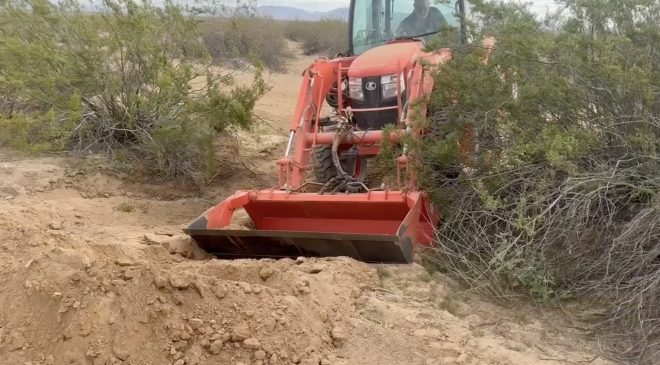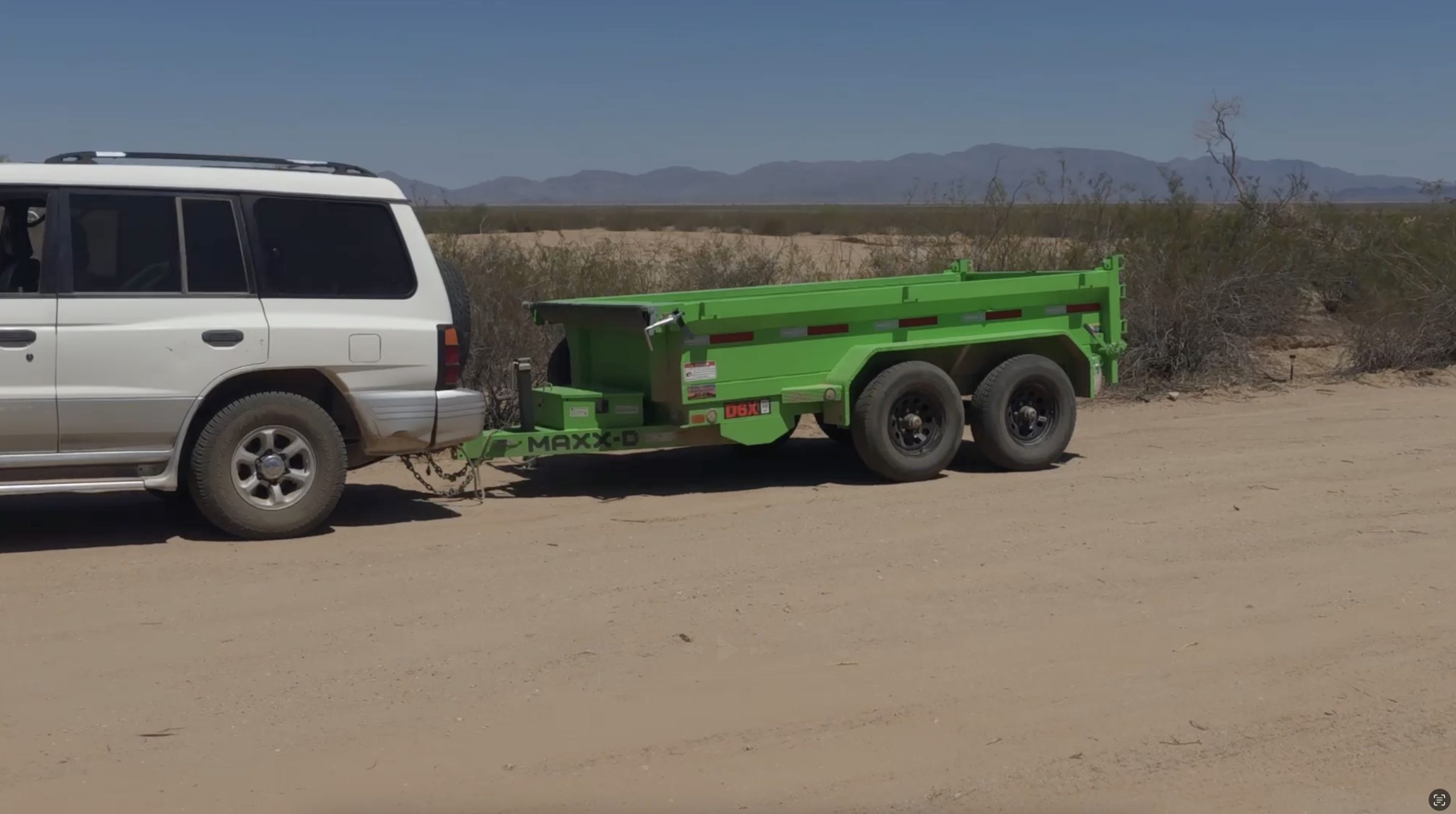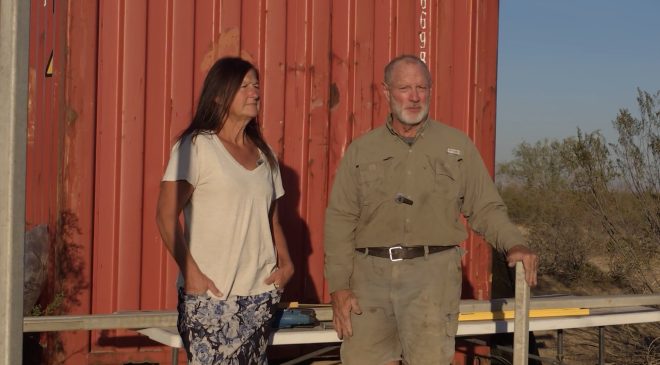
Potato Patch & Container Shuffle: Rainy Day Desert Moves!
In this episode of Occupy the Land, we seize a

In this episode of Occupy the Land, we dive into our off-grid desert homestead as we prep for monsoon season and advance our dome build! We showcase the versatility of our dump trailer for hauling materials, share plans for capturing monsoon water in our sand pond to store millions of gallons, and highlight the earthbag foundation for our dome. From setting up shade cloths to organizing solar racks and managing water flow, join us as we tackle the challenges of desert construction and share insights on sustainable living in the Arizona heat!
Now, this dump trailer is a crap, man, I mean. You gotta get one of these two things. A dump trailer and a tractor and a pickup trailer. My favorite thing I didn’t. I didn’t really want her to get it because I just didn’t know how useful it was me. But it’s actually kind of my dump trailer now. I use it all the time.
Yeah, and one of those little battery packs is what goes in there. We just plug it in and it charges that battery and it just keeps going because they said. And then you can check it here. You know now it’s getting low. And what they were saying yeah you could just dump it lift it and dump it about four times on the bottom like four times.
I don’t do it. I need like 40 times. So, we just put it in that battery pack and it just keeps going. Plus, I think when you got it plugged in to the vehicle, it charges it too. So there’s a lot of little projects, you know, that are going on. I’m all right. We’ll show you the dome here.
So you kind of get an idea of one of the main things working on this is the dome that, And we’ll put, we put shade cloth on the wind blows it off. And so that’s why we got those triangle things going to try that up here, see if they can hold up to the wind better. But, this is one of the work cables that we have.
And there’s a, table saw that’s on there for cutting. I gotta do one of the door frames, third door frame that we need for the dome over here. So this is just kind of a work area now. But it will go on top of this. So this is what we’ve done so far. The bathroom in there with all the drains and so on.
For that, there’s going to be utility and, laundry room and stuff over there. And you see the door frames. We took them down from here to make it easier to get in to do the concrete. So we have the center ten foot that we did. And then I got, you know, ready to do the next pour. We’ll get that tractor back, you know, today or tomorrow.
00:02:44:29 – 00:03:07:06
Unknown
We had some work done on it and it will start pour that because we have that, that, it’s hard for me to see a screen here. That mixer right there is for mixing concrete. It has a little door underneath. I flip a switch and it just, you know, dumps it right in to, where we’re working, housed on his car.
And we have, you know, the backhoe attachment that goes to it. We have a back blade, we have A41 yoke clamping bucket. And over there we got another bucket and a forklift. And so we have, you know, the accessories that we need. And then there’s a by the trailer, there is a diesel fuel cell that has like a, you know, a fuel pump and we pump that.
And so we’re going to be going, the next work that we’re doing is to, do the finished the floor here and we have four pours. So we have like one section, then we’ll do another one. I’m probably going to do the one over by that door first, and then we can get the door frames back. Because what we do is this material goes right up and we, we do cement, you know, in these first layers.
And when we do up next to the door frame, we put some Portland in there, even though a lot of it is going to be just Adobe. But we put that in, just really seal it in. And you do cleats of wood that go between the layers so you can screw that door frame in. And then we’ll have, we’ll be showing you where we put up, window frames and so on.
But this is the size of it. It’s pretty big. It’s a lot bigger than you think. When you get an enclosure, you go in, but the bathroom and some more storage and doing laundry and all that was just going to take up too much room. So screw it. We just had it on a room because this is an experiment.
Anyway, this is something that we wanted to try. A bunch of different coatings, different methods, different ways of doing, screening the cement and, you know, different design, traits. And how much of about, a awning that we have and a balcony, if we can put that up there and where the windows go and get the view, because what we’re doing, the bedroom is going to be here.
And that right there where you see that cement area, know, just had extra cement that came through. We had kind of wet and then the window and this is going to be our view. So I’m, looking forward to this, but where are the actual home is going to go is over on the other side of this wash.
So let’s go ahead and show you that.
Now you can see here the mixer, you know, it has an auger in there and a door in the bottom. And we know that’s how that works. So.
This wash is where one of the ones there’s several. There’s probably 4 or 5 that way where we control the water to make sure it goes to, where we’re going to be, store it in the sand pond. The reason you call it a sand pond is because it’s filled with sand. You know what? You don’t see the water.
That way you don’t have evaporation. You’ll get algae to get you. Oh, man. Made like aquifer. So as we source the material for building up this pad, because we need to raise it up, you know, at least 12, 18, 24in, you know, so that we don’t have any flooding of the home. So this home pad here is going to be coming from over there.
And as we go down in that, they we process this to a trommel that, I have, the equipment for and process the dirt to get down to the gravel and it just be gravel over there so that you have, the gravel displaces about two thirds of the space. So if you do, you know, six acre feet of pond area with the sand in it, that means you get two acre feet of water, you know, in the spaces and so on.
And it’s you know, protected from the light and much other stuff. Well, what happens is that means that one acre foot, one acre a foot deep, is 326,000 gallons. So times two is like a lot, you know, so we’re what, 680 some thousand. Yeah. I mean it’s a lot. So it will be fine. Now what we did is you can see just from one rain we had this was you know, it just looked like dirt.
You know, it was like a smooth, dirty compacted down here. And now you can see it’s just a bunch of gravel and sand. So when we process it through a trommel, we get all of our building material, our sand and gravel for this. This is how we’re the wash sand and the washes come from and it’s just processing this dirt.
So back there is the back part of the property. And that’s kind of our lay down yard. We put, you know, barrels and, you know, storage stuff and everything. And I’ll probably have a little workshop area there. And then this where the dome was the work workshop moving from that, that was temporary. We’re just taking that dome is probably going to go over here and be one of the garages or one of the buildings, but the the circle concrete platform that we did over there was for an outdoor, common area.
You know, we wanted to have, you know, fireplace and rocket stove, benches, heating, whatever thing. So we’re going to go ahead and do that. That’s where the fire happened. And we’ll give you a details on that later. But it was, you know, we learned the lesson and, we wanted to make ours a temporary thing anyway, so I don’t want to, like, we.
I got another cover I could put on it and ricochet there. We’ll just go ahead and, make it what it originally was intended for as a platform for community. Now I got 300. I don’t know if you can see over there 300 railroad ties, which is what they used here previously for doing the fence. And, I got a good deal on those.
I said that pulled the trigger. Boom. Bring them over. So that’s what we’re doing with that as a fence. Now, these are all greens that I did. I have an auger that goes on the back of the tractor. And I really should, you know, level out the mound. But it was too dry and I wanted to wait till it rained a little bit.
So the soil just wasn’t fill back in with moondust. And then we’ll level it and it will fill it in with, sand and then level it, because when the tractor has auger on the back and that mixing bucket on the front, I just scoop it up full of sand. I do the ordering back up though. It was sand auger back up fill.
It was sand. Because when you’re open to the air, that sand the water as we back this up, it just penetrates into the clay and the soil here, alluvial floodplain. Now when we do that, it moves about 12in every 24 hours. So when we had the monsoon, which be a common, we are going to be able to get the water to go into the soil instead of running off into the washes and off to the property, because what it does is this, you know, it creates this thin layer of clay and it doesn’t really penetrate that.
It just flows off. So I needed to get into the soil to charge it and have millions of gallons so that we can plant trees. And that’s what the plan is. So this is how we’re going to accomplish that. Now we’ve already done some test areas. It works really well. And we’re going to be focusing on that, I don’t know, maybe, you know, after it rains in the next weeks or so, it’s going to start raining.
And that way, you know, penetrate the ground a little bit to where it won’t be so powdery and we can go ahead and, put sand in it and it’ll hold back the soil so that the water will penetrate. Because one thing that’s interesting, we’re going to be doing, you know, dirty science, you know, dot info and it’s going to be all about the dirt and how you can use it and the different traits of it.
I found it fascinating doing some research. And I want to demonstrate that for people that, you know, build in the desert and do this stuff, because when we are looking, you can find it. It was like, you know, Washington University from 1950s, an old video that they digitized. I mean, really, it was a thing. And, when the soil gets saturated into the clay and it hits a band, you know, a stripe of, which happens a lot of times, like these washes and so on.
You go down like five feet and you’ll see a band of gravel. Well, that’s where all the gold is, by the way. But, also it, the water doesn’t penetrate through that from capillary action. It stays up in water and clay goes up as fast as it goes down from capillary action. Because clay is not necessarily a material, it’s a type of material.
It’s like, plates of minerals and different, you know, there’s different kinds of clays. It’s more a physical thing than it is a chemical thing. So what we are doing is making sure that, you have that knowledge of where if it goes into a band of sand, it doesn’t go further down the hole. It’s amazing.
We’re going to be going over how we can use that to our advantage. But we’re it’s open to the air at the top. And of course water just penetrates down. So we have a bunch of these. And this is where we’re putting, the sand dams to back this up so that it fills those holes. That’s what’s going on.
So we did this and this is how these now this is just a dome. There’s no, it’s not structure to dhoby. There’s no Portland cement in it or anything. Yeah. We’ve had, you know, a couple of years. This stuff holds up fine. You know, it’s. And if you covered this in a stucco, if we just put a coating on, it’ll last forever.
Yeah. Because that’s. Yeah, thousands of year old Adobe structures. As long as they’re in a cliff dwelling or they have a room for some kind or a shadow where you keep direct water from going on it, it’ll last forever, you know. So that’s what we’re building out here is, forever thing. Now. We still have, you know, some of the, pallets out here with tarps on.
Now, this this is another 30ft dome, you know, that we have that we already punched out and made. So this is what’s going on. This is what we’re doing. And we just wanted to kind of give you an idea of, you know, where we’re at, but it’s so much work that we have everything that needs to be done.
There’s a little here, a little there. And, we’re going to be focusing on the construction of the dome over here by the bus. And the drainage. Like, you know, I just got it. Sometimes I just spend a few days just taking soil out a lot of times when I need it and I need, like, these piles of dirt here are there for a reason.
You know, a lot of times we have different construction things that we’re doing or water that we want to divert. So I’ll be spending some time on that. And, so this is where we’re at now. This tree here, was where we had the outdoor shower, and we think that we’re probably going to do like a 16ft dome to be a utility, which originally was what this was going to be.
But we got into it and we’re like, yeah, we can make a nice little house and get out of the bus and do we just go ahead and do that? But this is where we had our outdoor shower here and it was awesome. So we’re going to go ahead and probably, use this area right here for building, Utility Dome.
So this is where we’re at. This is what we’re doing. And at each one of these, there’s so many little projects that we have that keeps us busy. And Donna is really good about making sure we got enough water. She does the water runs. And so on. But when we bring out the tanks and we start filling those up, then we’ll have to do that a lot less.
But we’re really counting on capturing the monsoon water, which there is a bunch of. And if you can capture it, you know, once a year it’ll last year, the whole year. So that’s what, you know, the long term plan is how are we could do a well. Well, probably not that deep, but it’s like $50,000, you know, to 70,000 and no guarantees here.
But, you know, I’d rather make it, more sustainable using the rain because it’s just out of principle. And I’d like to do that, and I’ll spend what it takes to do that. And time and money usually is just time and diesel, you know. So that’s what we’re working on now. Will probably buy the next video. We’ll have, the floor done in here, and then the walls will start going up pretty quick.
So you got that to look forward to.

In this episode of Occupy the Land, we seize a

In this busy-week update from Occupy the Land, Ernie finally
In this episode of Occupy the Land, we explore thriving